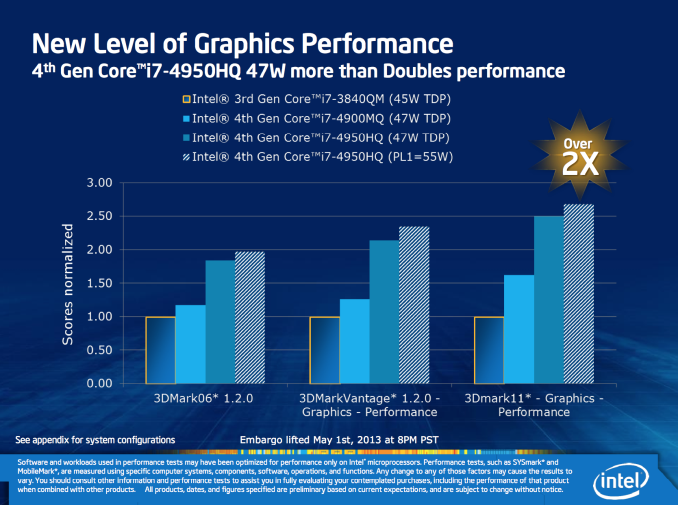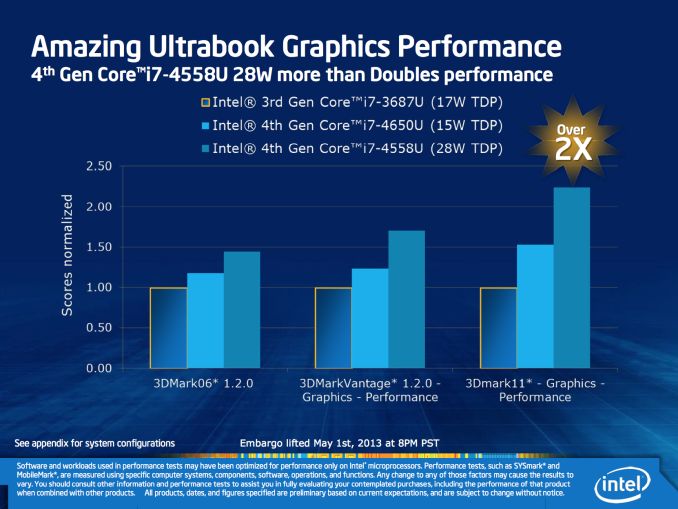Some Haswell TDPs Revealed: 15W & 28W Ultrabooks
by Anand Lal Shimpi on May 2, 2013 2:08 AM EST
Tonight Intel gave its (high-end) processor graphics a new name: Iris. Along with the new brand disclosure, Intel did let a few details slip about Haswell TDPs.
High-end desktop parts creep up to 84W (Core i7-4770K). All socketed desktop Haswell CPUs will either use Intel HD Graphics (GT1) or Intel HD Graphics 4xxxx (GT2). There's a new category of BGA-only (non-socketed) desktop CPU with an R-suffix that will ship with Intel Iris Pro graphics 5200 (GT3e). These R-series SKUs will top out at 65W, implying lower max CPU frequencies than the K-series SKUs but obviously delivering better graphics performance.
Quad-core notebook parts climb up from 45W to 47W, and these are the only parts that have the chance of getting Iris Pro graphics. Based on what we know thus far, an H-suffix seems to imply Iris Pro (Core i7-4950HQ) while an M-suffix is plain old Iris (Core i7-4900MQ). With an increase in TDP, it's entirely possible that we won't see any battery life improvement from quad-core mobile Ivy Bridge to Haswell unless you start including power savings from potentially getting rid of a discrete GPU.
Finally, the more interesting TDPs we have are down in Ultrabooks - these are parts that we've been calling Haswell ULT. Currently, Ultrabooks use 17W Ivy Bridge parts but those TDPs drop slightly with Haswell ULT down to 15W. There's no room for Iris down in the 15W range (power constraints, Intel doesn't want to regress on CPU performance), however Intel will be introducing 28W Haswell ULT parts to enable 14/15" and larger Ultrabooks with Iris graphics. The inclusion of a 28W Ultrabook part is very interesting as it clearly goes after notebooks like the ASUS UX32VD that attempted to pair a low end discrete GPU with low-power Intel silicon. Intel definitely has its eyes set on eating more of the BoM in the PC market, at the expense of the discrete GPU vendors of course. It will be very interesting to see how things play out over this next generation with low-end to mid-range discrete GPU attach rates.












30 Comments
View All Comments
HisDivineOrder - Thursday, May 2, 2013 - link
Here's hoping it's good enough to make a great Razer Edge tablet with Iris Pro.yhselp - Friday, May 3, 2013 - link
Highly unlikely. Iris Pro starts at 47W; and while the Edge is capable of cooling two chips with a total power consumption of about 37W, it wouldn't be able to handle a single 'big' chip at 47W. It would be able to handle Iris (non-Pro) in the form of the 28W chip, but this part probably wouldn't be significantly faster (if at all) than the 640 LE. Therefore, it makes more sense to offer the 2nd gen Edge with a 15W (or even lower) Haswell ULV coupled with a 700-series or higher GeForce.kirilmatt - Saturday, May 4, 2013 - link
Or they could offer a Kaveri ULV APU that could perform better at a lower TDP and costshing3232 - Thursday, May 2, 2013 - link
THIS IS JUST BENCHMARK...... I want real game bech.eanazag - Friday, May 3, 2013 - link
It is good to be a customer next year and end of this year. Performance pressure from Intel GPUs mean that the bottom falls out for discrete GPUs in laptops. Means that discrete vendors will have to put out much better parts than they care to or shrink away from that market totally. AMD will be sucking wind on their APUs. They are close to losing the only advantage they have. AMD needs a game changer. Will their ARM license start showing up?evilspoons - Saturday, May 4, 2013 - link
Looks like this should help out on the 13" Retina Macbook Pro. Interesting.kirilmatt - Saturday, May 4, 2013 - link
While it's good that intel is significantly increasing iGPU performance with Haswell there is little to no chance they will rival Kaveri especially with HSA and GCN. They will also lose to richland in iGPU performance. The other problem is that CPU performance is only about 5% better, 10% in certain benchmarks. AMD is increasing CPU performance much faster then Intel and their iGPU lead is not evaporating.jpal12 - Sunday, May 5, 2013 - link
The 28w ones could go into 13.3" ultrabooks as well, the MacBook retina 13" has a 35w ivy bridge, and haswell has an integrated voltage regulator, which should decrease the power consumption.MelodyRamos47 - Sunday, May 12, 2013 - link
just before I saw the check which had said $4099, I have faith that...my... cousin was truley erning money part time on there computar.. there sisters neighbour haz done this for only twentey months and just now took care of the dept on their villa and bought Ariel Atom. this is where I went, Bow6.comCHECK IT OUTKrysto - Tuesday, May 14, 2013 - link
So much for the "much more efficient" Haswell.I said it even before Anand thought about it, that if anything the "tablet" version of Haswell will be a VERY underpowered version of the chip., but for some reason Anand kept pushing the idea that Haswell will "get efficient enough" to be used in tablets.
But it's not "getting that efficient". It's only going to cut the performance dramatically to even achieve a 10W TDP, which is still far too high for a tablet - unless you want a 15,000 mAh battery in it, but good luck with the pricing and weight on that one.